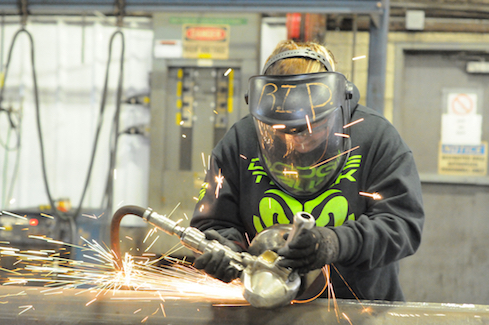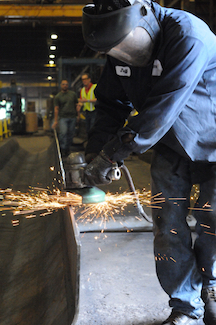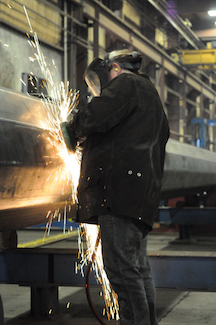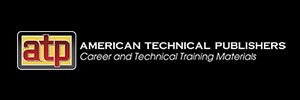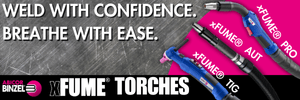How Safe Use of Cutting and Grinding Abrasives Benefits Productivity
Some operators learn as they go or get advice from coworkers who may (or may not) have received appropriate training. Unfortunately, learning about abrasives through trial and error can cause unnecessary accidents and injuries while negatively impacting productivity and costs.
Posted: May 6, 2020
SURFACE CONDITIONING COLUMN
BY RICK HOPKINS
Preparing, cleaning, and finishing the base metal is an important part of most welding operations. However, many operators haven’t received formal training in the safe and proper use of abrasive products for the job.
Operators might learn as they go or get advice from more seasoned coworkers who themselves may – or may not – have received the appropriate training. Unfortunately, learning about abrasives through trial and error can cause unnecessary accidents and injuries while negatively impacting productivity and costs. That’s why it’s so important to understand the safe and effective use of tools and abrasives when cutting, grinding, and cleaning metal.
Importance of Safety Training
Using abrasive tools as they are intended is important for several reasons. First and foremost, it can help prevent injuries to the operator and others working in the vicinity.
In addition, paying attention to safety can help operations reduce costs through decreased downtime for injuries or rework, potential worker’s compensation, and turnover and training of new operators. By reducing downtime, companies can also improve productivity.
The first training step is to educate users on how abrasive products are designed to be used and inform them of any limitations each product might have. A cutting wheel, for example, should be used at a different angle and orientation to the workpiece than a grinding wheel. Taking simple steps such as properly mounting the workpiece and jogging the tool a few times before touching it to the metal can help minimize safety risks and alert the operator to potential problems before work starts.
Common Safety Pitfalls
There are two common challenges that can pose safety hazards when using abrasives, both stemming from improper use of the products.
- Too much pressure. It’s human nature for operators to feel like they should push harder when an abrasive isn’t delivering the expected performance. But too much pressure increases friction, which increases heat, which breaks down abrasives at a much faster rate.
And just as with a knife blade, increasing pressure doesn’t typically improve performance with abrasive products. Instead of increasing the pressure in an attempt to get an abrasive to do a job it wasn’t designed for, consider the limitations of that product and decide if a different abrasive is a better answer.
- Improper orientation or angle. Abrasive products are made in specific profiles that have limits of orientation to the workpiece.
Cutting wheels are typically designed to be used at a 90-degree angle to the workpiece, for example, while flap discs are designed to be used at lower grinding angles that are closer to parallel to the work surface.
Using a cutting wheel in a grinding orientation to feather the edges of a weld or deburr the edge of the material — not the way it was designed to be used — may seem more convenient than changing the abrasive. But it puts significant stress on the wheel that can result in the product breaking down prematurely or worse: product failure.
Pushing an abrasive tool beyond what it’s designed to do can result in serious safety and performance issues.
How Safety Affects Productivity
Helping operators understand how products were designed to be used is an important step toward optimizing an abrasive’s performance and efficiency.
Proper use reduces the amount of downtime related to operator injuries. Any downtime spent on other tasks equals time not spent grinding or finishing the metal. Plus, no company wants an employee to be injured.
Improper use of abrasive products can also give less-than-optimal results that require time-consuming rework. Or it may reduce the durability or cut rate of the products in a way that negatively affects productivity.
Conversely, if companies can reduce changeover through proper abrasive use, they can also reduce the required inventory on hand — and the time and money spent buying and managing that inventory. That adds up to more time spent in finishing operations and greater throughput.
In addition, operators who use proper techniques and product orientation tend to feel less stress on their arms and body. They can work longer, so jobs get done more efficiently.
How Safety Affects Quality
Safe and proper use of abrasive products can also have an effect on the quality of the finished work and overall productivity. Using abrasives at an improper angle or applying too much pressure, for example, can cause problems such as heat discoloration, burr formation, gouging, or undercutting on the work surface.
These issues can be significantly reduced with safe and effective product use. This can help operations eliminate secondary or sometimes even third steps that may otherwise be required to fix or repair the base material — ultimately reducing the actual time spent on the job and improving productivity. As more shops work with tighter tolerances and compressed schedules, this becomes especially important; there isn’t much leeway to correct damage to the material or part.
One tip for reducing the risk of damage to the base material when grinding is to always enter the workpiece on a pull stroke rather than a push stroke. Starting with a push stroke increases the possibility of gouging the workpiece, whereas starting with a pulling motion can be done at a much lower angle and with less aggression and pressure, resulting in a smoother and more consistent stroke.
Cutting and Grinding Safety
Safety is a skill like any other and requires practice and repetition. The goal is to ensure operators keep safety top of mind and make it a part of the company culture. While accidents can happen at any time, encouraging everyone to put safety first helps minimize risks.
Also, as with any tool, safe and proper use allows operators to get more out of abrasives and optimize performance and efficiency.
Consulting an abrasives manufacturer about training on safe and proper use of products can provide companies and operators with the basics to help improve results.





